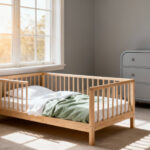Is your spatula drawer a war zone? Are you tired of that mini avalanche every time you open the Tupperware cabinet? If your kitchen feels more like a source of stress than a place of comfort, you’re not alone. The constant clutter isn’t just an eyesore—it’s a direct drain on your time and your focus.
As a designer who’s spent years creating efficient workspaces, I’ve seen how a well-organized environment can completely change your productivity and even your mood. And let’s be honest, your kitchen is a workspace. It’s where you prep, produce, and manage one of the most important parts of your day. A messy kitchen isn’t that different from a messy desk; it slows you down and creates friction where you need flow.
So, let’s borrow some principles from professional workspace design and apply them to the heart of your home. Here are 22 practical ways to get your kitchen storage under control, so you can finally reclaim your counters and your calm.
1. Start with a Ruthless Decluttering Session
Before you buy a single bin or basket, we need to talk. Trying to organize clutter is a losing battle. It’s like trying to file a stack of junk mail—pointless. You have to purge first. I’ve seen so many organization projects fail because people skip this step, and I won’t let that happen to you.

This is your chance to be brutally honest. Get rid of the expired spices from three years ago. The duplicate potato peelers. The avocado slicer you swore you’d use (we all have one). I once helped a client who had four garlic presses. Four. He lived alone. Set up a few boxes: Keep, Donate, Trash, and a “Relocate” box for things that have migrated to the kitchen but belong somewhere else. When you’re left with only the tools and foods you actually use, organizing them becomes infinitely easier.
Think of it this way: The goal isn’t just a tidy kitchen, it’s a kitchen where every single item earns its keep. Once you’re down to the essentials, the real design work can begin.
2. Categorize and Zone Your Kitchen Items
Now that your kitchen is significantly lighter, it’s time to build a system that actually makes sense. In office design, we call this “creating a workflow.” In the kitchen, it’s all about zoning. This means grouping similar items together and storing them exactly where you use them. Simple, right? But it’s a game-changer.

Think about your daily movements. Your cooking oils, spices, and favorite pans should live near the stove (the “Cooking Zone”). Your knives and cutting boards belong next to your main prep counter. Plates, bowls, and silverware? Store them as close to the dishwasher as you can to make unloading a breeze. This isn’t about rigid rules; it’s about creating an intuitive map for your own habits.
I’ve noticed the most functional kitchens aren’t the ones with the most gadgets, but the ones where everything is placed with intention. You should be able to move through your cooking process without backtracking or frantically searching. When your zones are set, you can start optimizing the space within them.
3. Maximize Vertical Space with Shelf Risers
Go open one of your cabinets. I bet you there’s a ton of empty air between your stack of plates and the shelf above it. That wasted vertical space is prime real estate. Shelf risers are your best friend here. These simple, inexpensive stands essentially create a second level on your existing shelf.

Instead of one wobbly stack of bowls, you can have a short stack on the shelf and another on the riser right next to it. Suddenly, everything is visible and you don’t have to play Jenga just to grab a cereal bowl. These are perfect for plates, mugs, canned goods, you name it. They bring everything into view and instantly make your cabinets feel twice as big.
Just do yourself a favor: measure first. Check your cabinet height and depth, and the height of the items you want to store. A few minutes with a tape measure will save you the headache of a return. From grabbing more vertical space, let’s tackle the horizontal chaos of drawers.
4. Implement Drawer Dividers for Utensils and Gadgets
Let’s talk about the “utensil drawer”—that tangled nest of whisks, spatulas, and can openers. We all have one. It’s where productivity goes to die. Drawer dividers are the immediate fix for this kind of chaos, transforming that jumble into a beautifully organized command center.

Giving every tool its own designated slot means you can find what you need without a frantic search. It also protects your utensils. No more bent spatulas or nicked wooden spoons. I’m a big fan of adjustable bamboo dividers; they look great and you can customize them to fit your specific tools and drawer dimensions perfectly. But even a simple plastic tray will make a world of difference.
This is one of the quickest and most satisfying organizational wins in the entire kitchen. While dividers tame your shallow drawers, we need a different strategy for those deep, dark base cabinets.
5. Utilize Pull-Out Organizers in Deep Cabinets
Deep base cabinets are the black hole of the kitchen. They’re where pots go to be forgotten and small appliances disappear forever. You shouldn’t need a headlamp and a search party to find your blender. This is where pull-out organizers are, frankly, a lifesaver.

These systems are basically shelves or baskets on gliding tracks. Instead of kneeling on the floor and reaching into a dark abyss, you just slide the entire contents of the cabinet out to you. Everything is visible and within reach. This is especially good for heavy items like a Dutch oven or your stand mixer. The ergonomic benefit alone is huge—it saves your back and your knees.
Some people hesitate at the installation, but many modern units are surprisingly easy to put in. It’s a small weekend project that will pay you back in saved frustration every single day. They’re amazing for pots and pans, but there’s an even better way to store your cookware.
6. Store Pots and Pans Vertically with Racks
I can hear the sound right now—that horrible scrape of one non-stick pan being dragged across another. Stacking cookware is just a bad habit we all picked up. It scratches the surfaces, creates unstable piles, and makes grabbing the bottom pan a total pain. The solution is simple: store them vertically.

Using a vertical rack, where each pot and pan gets its own slot, is like giving them their own parking spaces. You can slide any piece out without disturbing the others. It saves a ton of time and, more importantly, it protects your investment in good cookware. You can find simple wire dividers for deep drawers, sturdier racks for cabinets, and even pull-out systems designed specifically for this.
This is a trick I learned from professional kitchens where efficiency is everything. What really gets me is when a client realizes they don’t have to unstack five pans to get to the one they need. It’s a true “aha” moment. Of course, this leaves one problem… the lids.
7. Organize Lids Separately Using Lid Holders
Ah, lids. The rogue agents of the kitchen. They slide around, never stack neatly, and are impossible to find when you need them. The key to taming them is to give them their own, separate home.

There are brilliant organizers designed just for lids. Some are simple vertical racks you can put on a shelf. Others are designed to mount on the inside of a cabinet door, taking advantage of that completely unused space. Separating the lids from the pots lets you nest your pots more tightly, saving space, and you can instantly grab the lid you need without a search.
This is one of those small tweaks that has an outsized impact on your daily frustration levels. It feels so good to conquer the lid monster. From lids, let’s move to another notoriously tricky area: the corner cabinet.
8. Use Lazy Susans for Corner Cabinets or Spices
The corner cabinet is another dead zone. It’s so deep and awkward that whatever goes in the back might as well be on a mission to Mars. A Lazy Susan—basically a rotating tray—is the classic and still best solution for these spaces.

With a simple spin, you can bring everything from the back right to the front. Nothing gets lost, and you can actually use the full depth of the cabinet. They make “kidney-shaped” ones designed specifically to fit in corner cabinets. But don’t just think of them for corners! A small, tiered Lazy Susan on a pantry shelf is my favorite way to organize spices. A quick twirl and you can see every single label.
You’ll stop buying duplicates of spices you already have, which not only saves money but also reduces food waste. It’s a win-win. Utilizing hidden space is a theme here, and walls offer another great opportunity.
9. Employ Magnetic Strips for Knives and Metal Utensils
If you’re short on counter space, getting your knives off the block is a game-changer. A magnetic strip on the wall is a sleek, space-saving solution that I see in almost every professional kitchen. It keeps your most-used tools visible and instantly accessible.

It’s also more hygienic than a traditional knife block, where moisture can get trapped in the slots. On a magnetic strip, your knives air dry completely. And for anyone who has invested in good knives, it’s a better way to store them—the blades aren’t getting dulled by rattling around in a drawer or scraping against the inside of a block.
Just make sure you get a strip with a strong magnet. It should hold your heaviest chef’s knife without any slippage. The functionality and the clean, modern look make this a personal favorite of mine.
10. Install Hooks Inside Cabinet Doors for Measuring Cups
Here’s a five-minute fix for a daily annoyance. Where are your measuring cups and spoons right now? Probably tangled up in a drawer or lost on a shelf somewhere. Grab a few small adhesive hooks (like Command hooks, which are great for renters) and stick them to the inside of your baking cabinet door.

Hang your measuring cups and spoons on the hooks, and they’ll be organized, out of the way, but right there when you need them. No more digging. Just make sure you position them so they don’t bang into the shelves when you close the door.
It’s such a simple, cheap trick, but the satisfaction you get from it is huge. It’s all about removing those tiny points of friction from your day. Next, let’s bring that same level of order to your pantry staples.
11. Decant Dry Goods into Clear, Stackable Containers
I know, I know. Decanting your flour, sugar, and pasta into matching containers can feel a little extra, like something you only see on Instagram. But trust me on this one. From a functional design perspective, it’s brilliant. The original packaging is bulky, flimsy, and impossible to stack efficiently.

Switching to clear, airtight, stackable containers is transformative. First, you can see exactly what you have and how much is left at a glance, which makes grocery shopping so much easier. Second, the airtight seal keeps food fresher for longer and protects it from pests. And third, the uniform, stackable shapes let you maximize every inch of vertical shelf space. Your pantry will look incredible, but more importantly, it will work so much better.
Choose containers with wide openings for easy scooping and pouring. It’s an upfront investment of time, but it sets up a system that practically maintains itself.
12. Organize Spices on a Tiered Rack or in a Drawer Insert
If you’ve ever bought a second bottle of cumin because you couldn’t find the first one buried in your cabinet, this one’s for you. A disorganized spice collection is a guaranteed way to waste time and money. The goal is to see every label at once.

A tiered rack that you place on a cabinet shelf is a fantastic option. It elevates the back rows so you can see everything. Another great solution, if you have the drawer space, is a drawer insert that holds the jars on an angle, letting you read all the labels from above. A quick scan, and you can grab exactly what you need.
It makes cooking more fluid and enjoyable when you aren’t hunting for the paprika. You’ll use your spices more, they’ll stay fresher, and your food will taste better for it. Beyond spices, there’s another versatile tool we need to talk about.
13. Designate Bins or Baskets for Specific Items
Bins and baskets are the workhorses of kitchen organization. They are perfect for corralling all those awkwardly shaped items and creating clear boundaries. Think of them as drawers you can place on a shelf.

Use one bin for all your baking supplies—vanilla extract, sprinkles, baking soda. Use another for grab-and-go snacks for the kids. Another for extra pasta boxes. By containing these categories, you prevent them from spilling all over your shelves. It also creates visual calm. A collection of tidy baskets is much more serene than a jumble of colorful, mismatched packaging.
You can use them everywhere: in the pantry, in deep cabinets, under the sink, and even in the fridge to group things like yogurts or condiments. They are incredibly flexible tools for imposing order on chaos.
14. Keep cleaning supplies Tidy Under the Sink with a Caddy
The cabinet under the sink is usually a damp, dark space complicated by pipes and a garbage disposal. It’s no wonder it becomes a chaotic mess of half-empty spray bottles and old sponges. The easiest way to bring order to this space is with a simple cleaning caddy.

Putting all your essential cleaning supplies into a caddy with a handle means you can pull everything out at once. No more knocking over bottles to get to the one in the back. It also protects your cabinet from drips and spills. Plus, if you need to clean the bathroom, you can just grab the entire caddy and go.
This little system ensures the tools you need to keep your kitchen clean are themselves clean and organized. From cleaning supplies, let’s address another set of awkward, flat items.
15. Store Cutting Boards and Baking Sheets in Vertical Dividers
That loud CLANG of a baking sheet slipping out of a wobbly stack and hitting the floor—sound familiar? Storing flat items like cutting boards, baking sheets, and muffin tins horizontally is inefficient and risky. The solution, once again, is to go vertical.

Install simple wire or wood dividers in a deep base cabinet (the one above the oven is a perfect spot). This creates individual slots for each item. You can slide a single baking sheet out smoothly and quietly, without having to lift the entire heavy stack.
It utilizes the full height of your cabinet and prevents your pans and boards from getting scratched and warped. This is another one of those simple fixes that homeowners tell me they wish they had done years ago.
16. Use Wall-Mounted Racks for Cookware or Utensils
In smaller kitchens where every inch of cabinet space is precious, you have to look up. Your walls are an untapped storage resource. A sturdy wall-mounted pot rack or a simple rail system with hooks can free up an entire cabinet.

Putting your most-used pots, pans, and utensils on the wall not only saves space but also enhances your workflow. When you’re in the middle of cooking, you can simply reach out and grab what you need. No digging required. It adds a bit of that professional, “chef’s kitchen” vibe while being incredibly practical.
This is a core principle of good design: if you can’t build out, build up. Use that vertical space to your advantage.
17. Organize Linens (Towels, Dishcloths) Neatly in a Drawer or Basket
Even something as simple as dish towels can contribute to the feeling of chaos if they’re just shoved in a drawer. Taking a moment to fold or roll them neatly makes a surprising difference. You can fit more in the drawer, and you can see what you have without rummaging.

I’m a big fan of the vertical folding method (popularized by Marie Kondo) where you fold items into small rectangles and “file” them in the drawer standing up. When you open the drawer, you can see every single towel at a glance. If you don’t have a spare drawer, a nice-looking basket on an open shelf or the counter works just as well.
It’s a small detail, but a collection of tidy linens just feels more peaceful and put-together. Next, let’s apply that same intentionality to one of our most important daily rituals.
18. Create a Dedicated Station for Coffee or Tea Supplies
For most of us, the morning coffee or tea ritual is non-negotiable. So why are the supplies scattered all over the kitchen? Coffee beans in the pantry, mugs in one cabinet, filters in another, sugar on the counter. It’s inefficient. Centralize it all by creating a dedicated beverage station.

Designate a small section of your counter, a bar cart, or a couple of floating shelves. Gather your coffee maker or kettle, your beans or tea bags, mugs, sugar, and stirrers all in one place. Store the coffee and tea in nice canisters. Put your mugs on a small tray. It turns a frantic morning scramble into a smooth, enjoyable ritual.
By creating these small, dedicated “zones of delight,” you make your daily routines feel less like chores and more like moments of self-care.
19. Store Small Appliances on Pull-Out Shelves or a Cart
That heavy stand mixer. The bulky air fryer. The blender you use for smoothies. These small appliances are countertop hogs, but they can be a pain to haul out of a deep cabinet. This is where an “appliance garage” or pull-out shelf comes in.

If you have a deep base cabinet, you can install a heavy-duty pull-out shelf to make accessing these items effortless. Another great option is a freestanding cart with wheels. You can store your appliances on the cart and simply roll it out when you need it, then tuck it away when you’re done. There are even special spring-loaded lifts that bring a mixer from inside a cabinet up to counter height.
The goal is to get these items off your precious work surface while keeping them easy to access. A clear counter is a productive counter.
20. Label Everything for Easy Identification
You can have the most beautifully organized pantry in the world, but if you can’t tell the all-purpose flour from the bread flour, the system will fall apart. Labeling is the crucial final step that makes your organization sustainable.

Label your clear containers. Label the bins in your pantry (“Snacks,” “Baking,” “Pasta”). Put a label on leftover containers in the fridge with the contents and the date. This isn’t about being fussy; it’s about clear communication—with your future self, and with everyone else in your household. It eliminates guesswork and makes it easy for everyone to put things back where they belong.
A good system runs on clarity. Labels provide that clarity and keep your hard work from unraveling after a week.
21. Utilize Over-the-Door Storage for Pantry or Cabinet Doors
We’ve talked about using the inside of cabinet doors for lids and measuring cups, but don’t forget your main pantry door. The back of that door is a goldmine of vertical storage space. An over-the-door rack can hold an incredible amount of stuff.

These racks are perfect for things like spice jars, canned goods, bottles of oil and vinegar, and boxes of foil and plastic wrap. It gets these items out of your crowded pantry shelves and makes them incredibly easy to see and grab. It’s a classic small-space solution that works in any size kitchen.
You’re essentially adding a whole new column of shelving to your pantry without any construction. It’s one of the smartest ways to squeeze more storage out of the space you already have.
22. Keep Countertops Clear by Storing Items Away
This is it. This is the grand prize. After you’ve zoned your kitchen, optimized your cabinets, and created a home for everything, you can finally achieve the ultimate goal: clear countertops.

A clear counter is more than just an aesthetic choice. It’s the primary work surface in your kitchen. Keeping it free of clutter gives you the physical space you need to prep and cook comfortably. It gives you the mental space that comes from an orderly environment. And it makes cleanup about ten times faster.
With all the smart storage solutions you’ve put in place, you now have a place to put away the toaster, the utensil crock, and the fruit bowl. A clear counter is the visible reward for all your organizational efforts. It’s the sign of a kitchen that truly supports you.
A Kitchen That Works For You
Look, transforming your kitchen doesn’t happen in an afternoon. It’s a process. It starts with the hard work of letting go of things you don’t need and continues with the thoughtful work of creating systems that fit your life.
But every single one of these ideas is a step toward that goal. Start small. Tackle one drawer this weekend. Put up some hooks inside a cabinet door next week. The changes will start to build on each other, creating a ripple effect of calm and efficiency.
The reward is huge. It’s a kitchen that works for you, not against you. A space that reduces stress instead of creating it. You’ll save time, waste less food, and maybe even find that you enjoy cooking again. That’s the power of good design—it gives you back your space, your time, and your peace of mind.






